
We first describe some basic patterns of agricultural productivity and innovation in Africa. Figure 2 shows agricultural yields for cereals (as measured in value/hectare) in Africa vs. the world over the last 60 years. Both the level and growth rate of yields in Africa lags behind other regions. Of course, looking at Africa as a whole masks considerable heterogeneity. For example, in more detailed breakdowns from the same data, cereal yields in the Southern Africa region have climbed substantially to $900/hectare in the last decade or so, while yields in countries of West Africa and North Africa rose more modestly to about $500/hectare and yields in Central and East Africa have risen only slightly to about $300/hectare.
Figure 2: Cereal yields (‘000 US$/hectare) by region of the world, 1961-2018
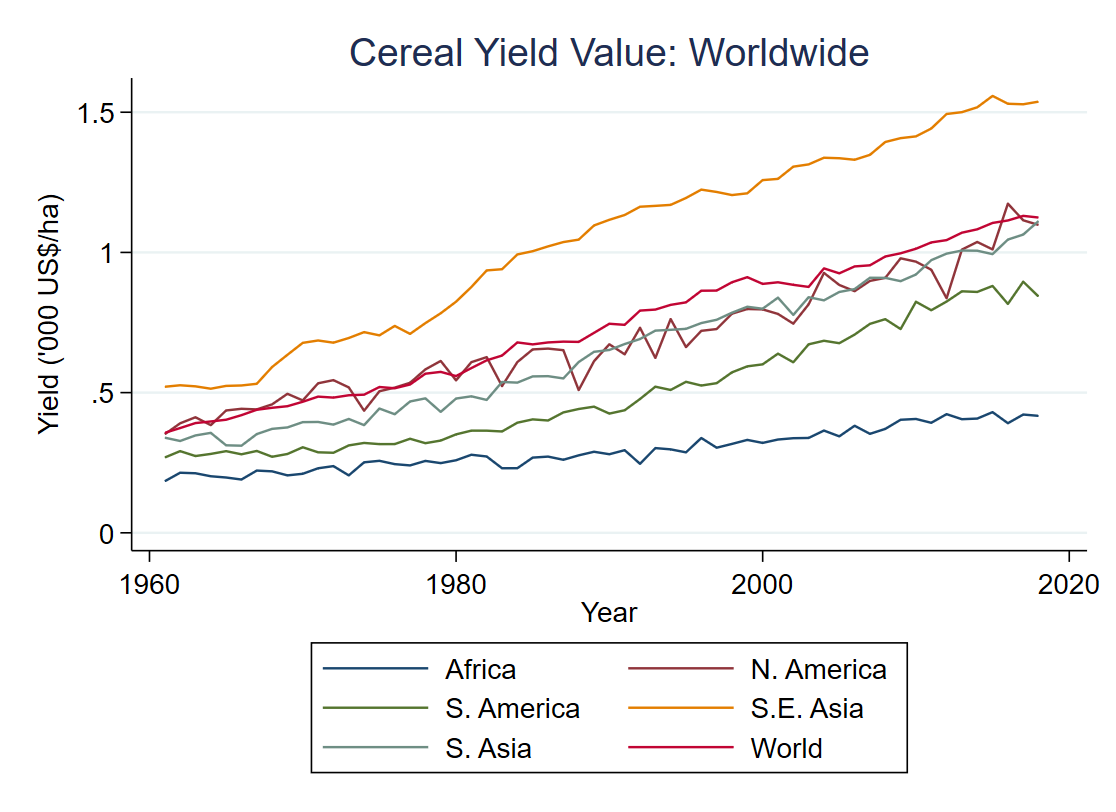
These yield gaps may in part be explained by variation in farm size. Figure 3 shows some of this variation, highlighting how the average farm size now is likely not that different in Africa compared to South Asia (though both these regions have dramatically smaller farm sizes than Latin America and the high-income countries). It is worth noting, however, that methodological and definitional differences across countries and time periods mean that data on farm size may be noisier (see Lowder et al. 2016).
Figure 3: Average farm size by region of the world, 1960-2000
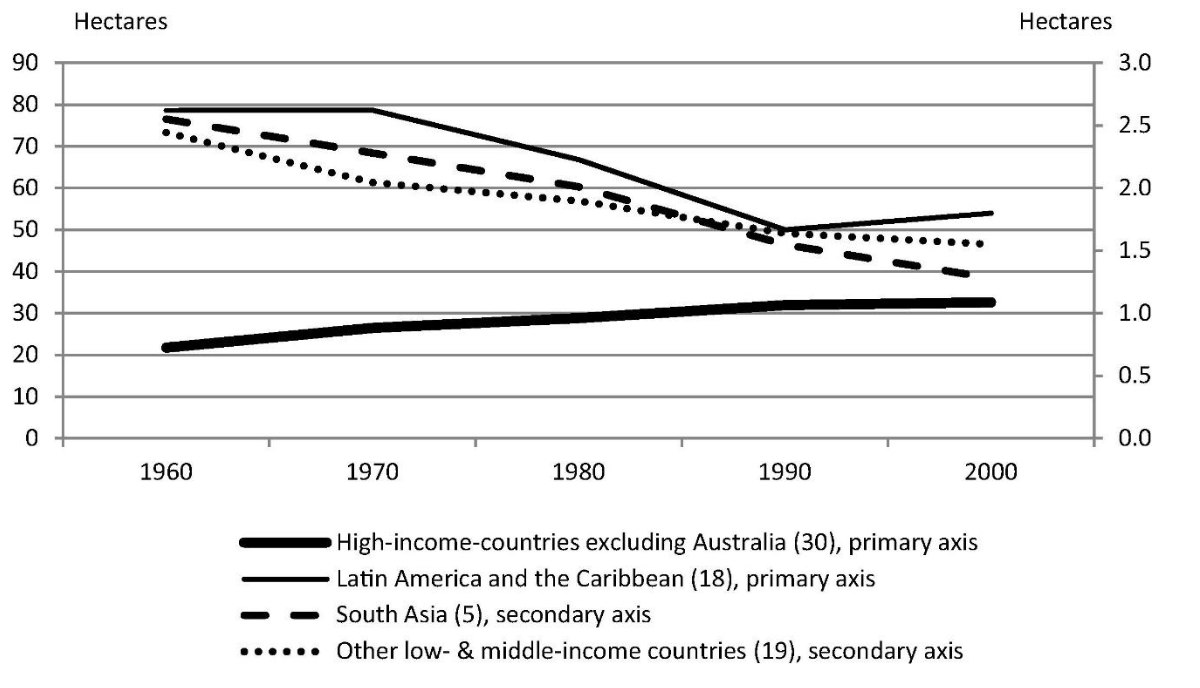
Yield gaps across the world and across Africa are largely a consequence of the dramatically different technologies being used. Technologies in agriculture involve the biophysical processes of plant and animal growth, coupled with anthropogenic management to create the spatially uniform conditions that distinguish a farm from natural growth. Agricultural technology is embedded in seeds, breeding stock, chemical inputs such as fertiliser, insecticides and pesticides; agronomic practices such as fallowing patterns and plant spacing; and equipment like hand tools, tractors or pumps and other irrigation and water management tools. Use of these technologies varies considerably across regions of the world. For example, Figure 4 Panel A compares fertiliser use in Africa to that in other regions of the world while Panel B compares across regions within Africa. Other regions in the world mostly caught up to North American fertilisation rates at least two decades ago, but Africa still lags far behind. The small increases in fertiliser use on the continent as a whole mask considerable heterogeneity in fertiliser use rates within and among countries (Sheahan and Barrett 2017).
Figure 4: Fertiliser use (Kg/hectare), 1961-2018
Panel A: By region of the world
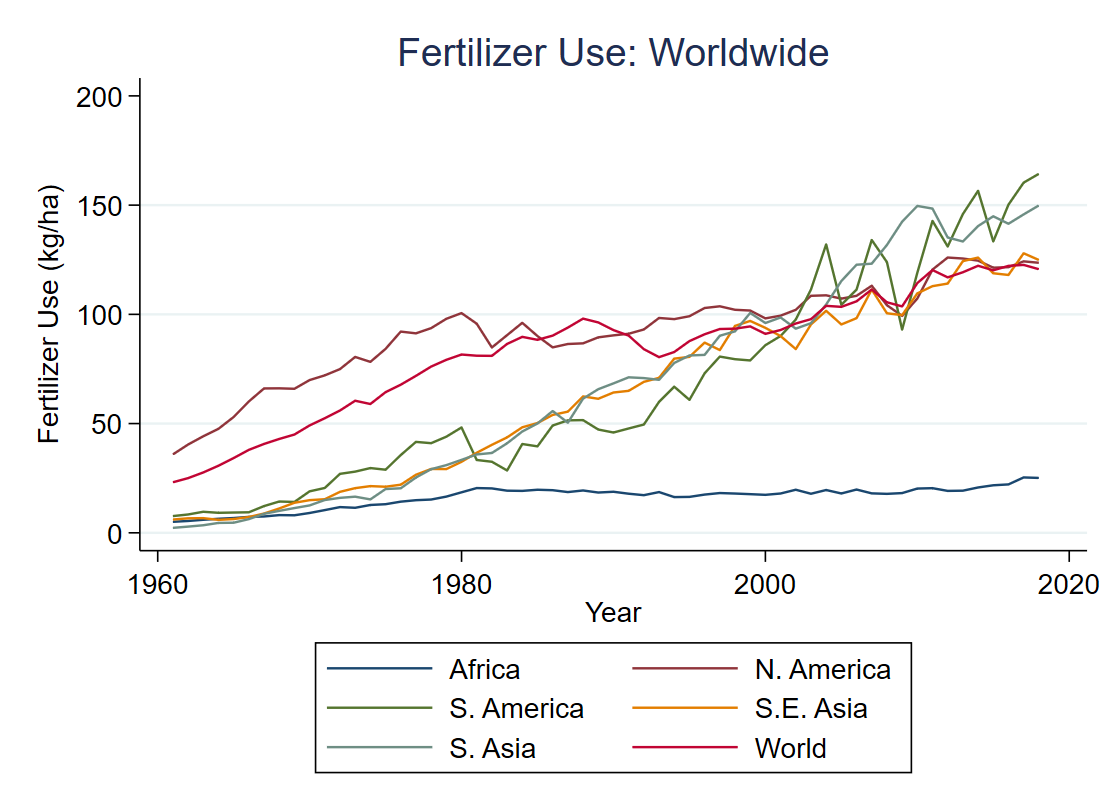
Panel B: Across regions in Africa, 1961-2018
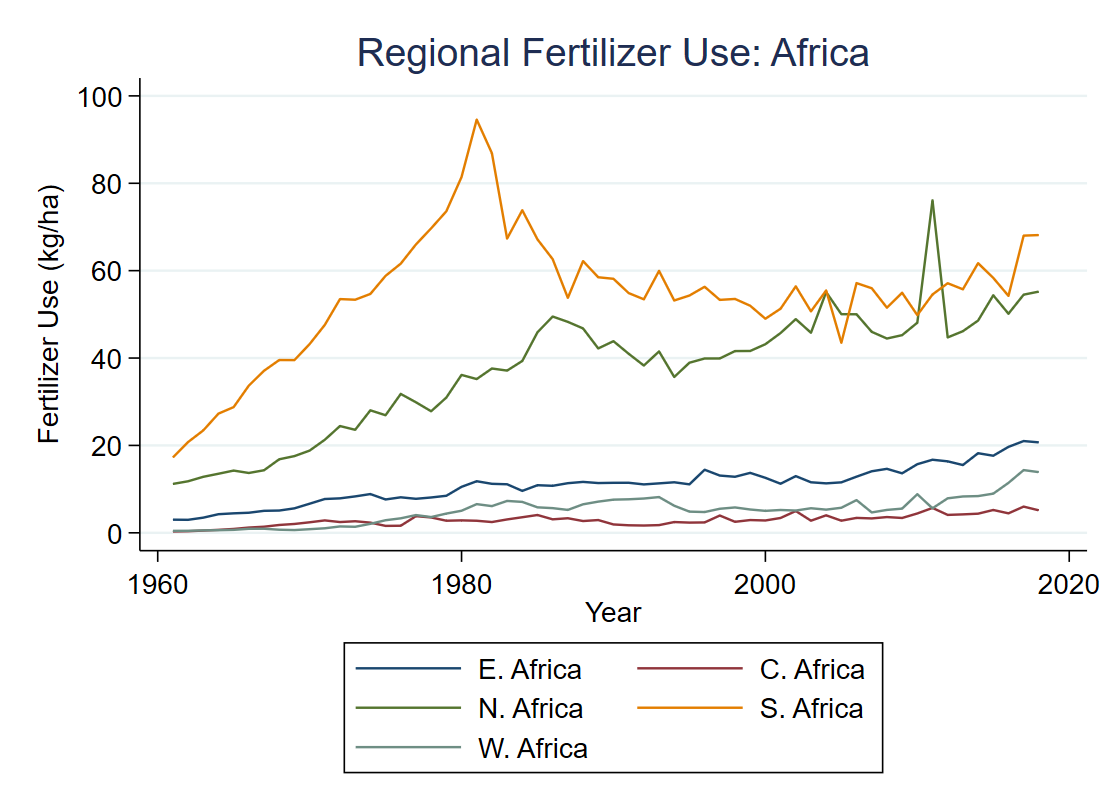
Africa also lags far behind other regions of the world in the use of irrigation. Irrigated land is roughly twice as productive, on average globally, as unirrigated land (Fuglie 2008). But as shown in Panel A of Figure 5, the share of agricultural land area equipped for irrigation remains at approximately 0.005 for the continent, compared to over .025 for the world. Again, regions of Africa exhibit substantial heterogeneity: most irrigation is concentrated in North and South Africa (Panel B, Figure 5). Almost all farmers in West, Central and Eastern Africa rely exclusively on rainfall for crop cultivation.
Figure 5: Trends in irrigation, 1960-2020
Panel A: Share of land equipped for irrigation in Africa vs. the rest of the world
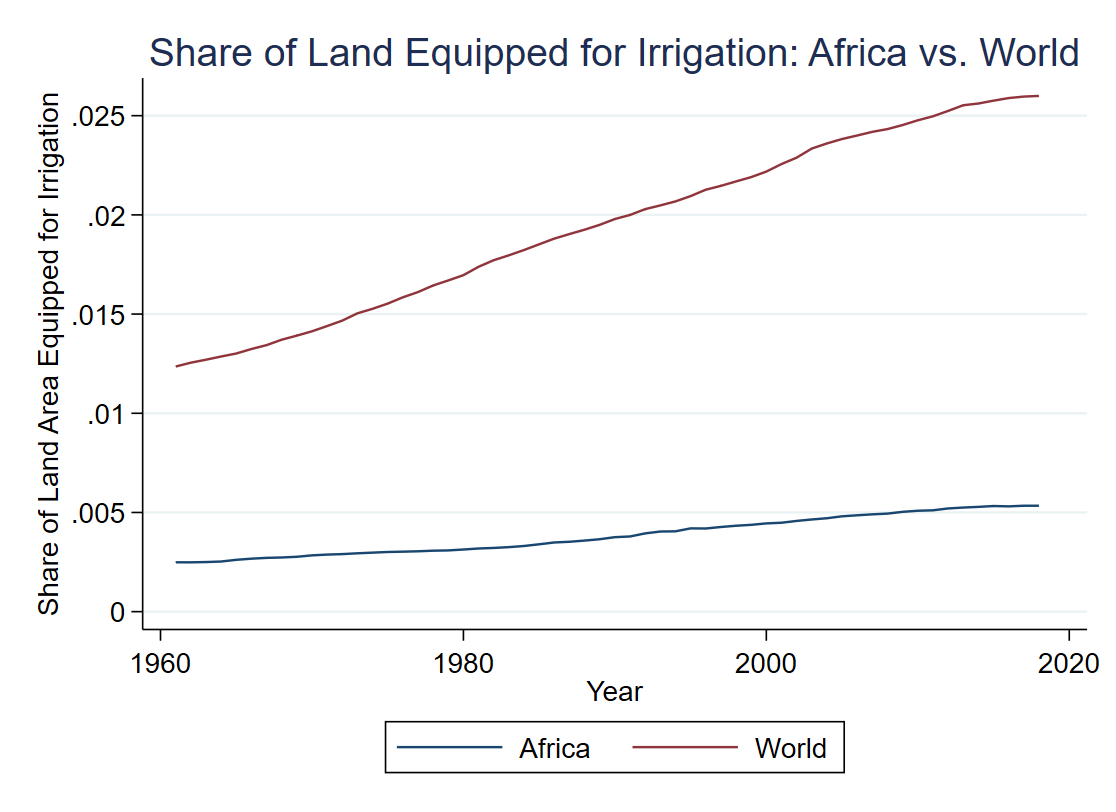
Panel B: Share of land equipped for irrigation across regions in Africa
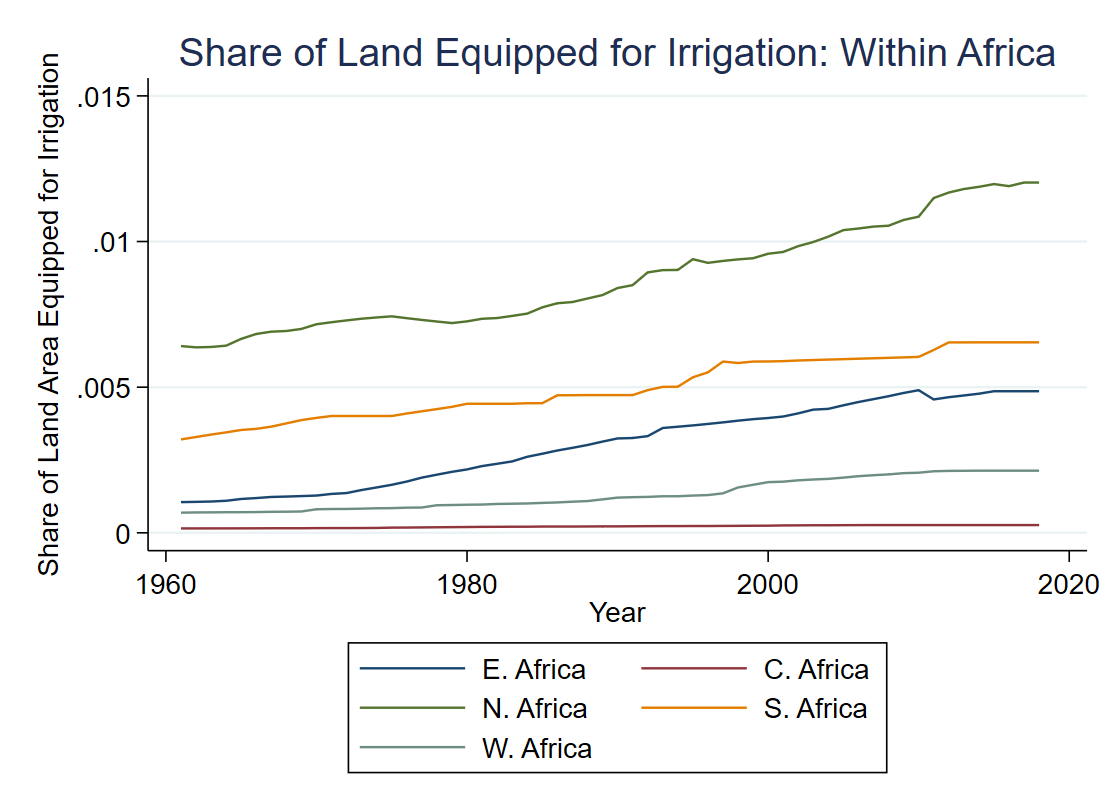
Fertiliser and irrigation are two key agricultural technologies. As we discuss later in the paper, they also reduce heterogeneity in the characteristics of land: for example, irrigation projects partially level out natural differences in farmland’s water supply. In turn, the extent of land heterogeneity has implications for how widely other technologies like seed varieties and cultivation practices can be disseminated.
Total Factor Productivity estimates reinforce the conclusion that African agriculture has lagged
Total agricultural output growth can arise from extensification through expansion of the agricultural frontier into previously uncultivated lands, intensification through increased use of non-land inputs, productivity growth using existing land and other inputs, or some combination of the three. Over the initial couple of post-colonial decades, most African agricultural output growth arose from extensification. Such resource-driven growth imposes significant environmental externalities and faces intrinsic limits. Expansion of Africa’s agricultural frontier has slowed since the 1980s - albeit not in all countries – and the continent remains home to roughly 60% of the world’s remaining arable land (Lambin et al. 2013).
As African farmers have intensified agricultural production - i.e. added more non-land inputs like fertiliser, irrigation and labour to the same cultivated area – output and yields have increased, but so have costs of production. While yields grew, agricultural output per worker largely stagnated (Barrett and Upton 2013). That is a basic reason why yields are not an especially good measure of agricultural productivity; they reflect only partial productivity per unit land cultivated. Economists therefore typically prefer total factor productivity (TFP) - roughly speaking, total output value adjusted for the value of all inputs – as a productivity measure. The TFP data reinforce the conclusion that African agriculture has lagged. African agricultural TFP growth to 2010 was only half the rate of the rest of the developing world (Fuglie and Rada 2013). And African agricultural TFP rose only 2% total over the decade since 2010, with only 14 out of 48 countries registering positive agricultural TFP growth from 2010-2021 (Figure 6). TFP growth is the real driver of structural transformation as output per agricultural worker grows, freeing labour to migrate to non-agricultural sectors, and the returns to land and capital rise as well, generating investible capital for non-farm enterprises (Barrett et al. 2017). Indeed, Yeboah and Jayne (2018) show that a strong negative association exists between agricultural TFP growth and the share of employment in agriculture across African countries.
Figure 6: Agricultural TFP Growth 2010-11 to 2020-21
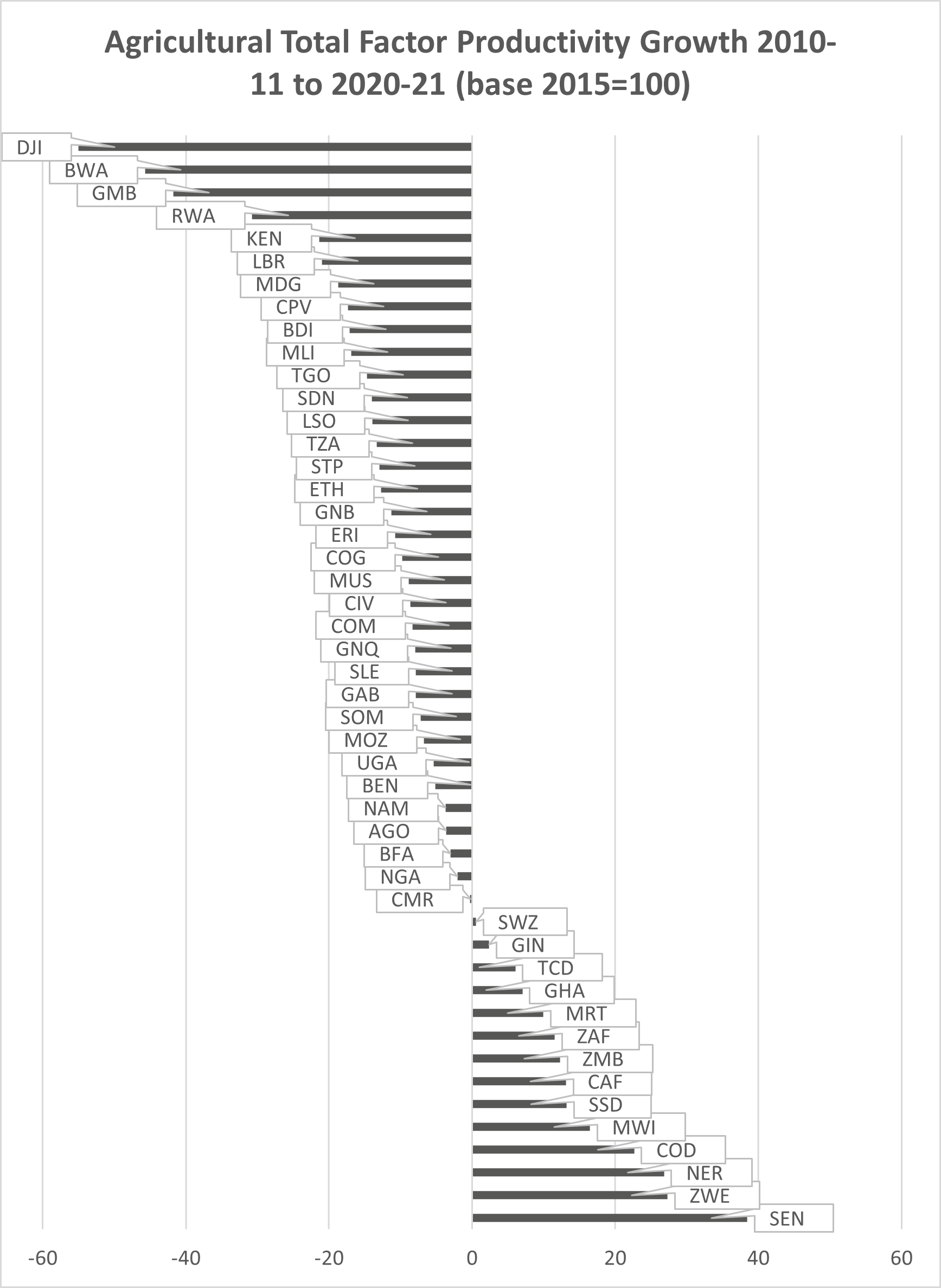
References
Barrett, C B and J B Upton (2013), “Food security and sociopolitical stability in sub-Saharan Africa”, in C B Barrett (ed.), Food Security and Sociopolitical Stability, Oxford University Press.
Barrett, C B, L Christiaensen, M Sheahan and A Shimeles (2017), “On the structural transformation of rural Africa”, Journal of African Economies, 26(suppl_1): i11-i35.
Christiaensen, L and L Demery (2017), Agriculture in Africa: Telling Facts from Myths, Washington, D.C.: World Bank Group.
Fuglie, K O (2008), “Is a slowdown in agricultural productivity growth contributing to the rise in commodity prices?”, Agricultural Economics, 39: 431–441.
Fuglie, K and N Rada (2013), “Resources, policies, and agricultural productivity in sub-Saharan Africa”, USDA-ERS Economic Research Report, (145).
Lambin, E F, H K Gibbs, L Ferreira, R Grau, P Mayaux, P Meyfroidt and J Munger (2013), “Estimating the world's potentially available cropland using a bottom-up approach”, Global Environmental Change, 23(5): 892-901.
Lowder, S K, J Skoet and T Raney (2016), "The number, size, and distribution of farms, smallholder farms, and family farms worldwide", World Development, 87: 16-29.
Sheahan, M and C B Barrett (2017), “Ten striking facts about agricultural input use in Sub-Saharan Africa”, Food Policy, 67: 12-25.
United Nations, Food and Agriculture Organization (FAOSTAT), https://www.fao.org/faostat/en/#data.
U.S. Department of Agriculture, Economic Research Service (2023), “International Agricultural Total Factor Productivity Indices”, https://www.ers.usda.gov/data-products/international-agricultural-productivity/.
The World Bank, World Development Indicators (WDI), http://wdi.worldbank.org/table/2.3.
Yeboah, F K and T S Jayne (2018), “Africa’s evolving employment trends”, Journal of Development Studies, 54(5): 803-832.
Contact VoxDev
If you have questions, feedback, or would like more information about this article, please feel free to reach out to the VoxDev team. We’re here to help with any inquiries and to provide further insights on our research and content.




